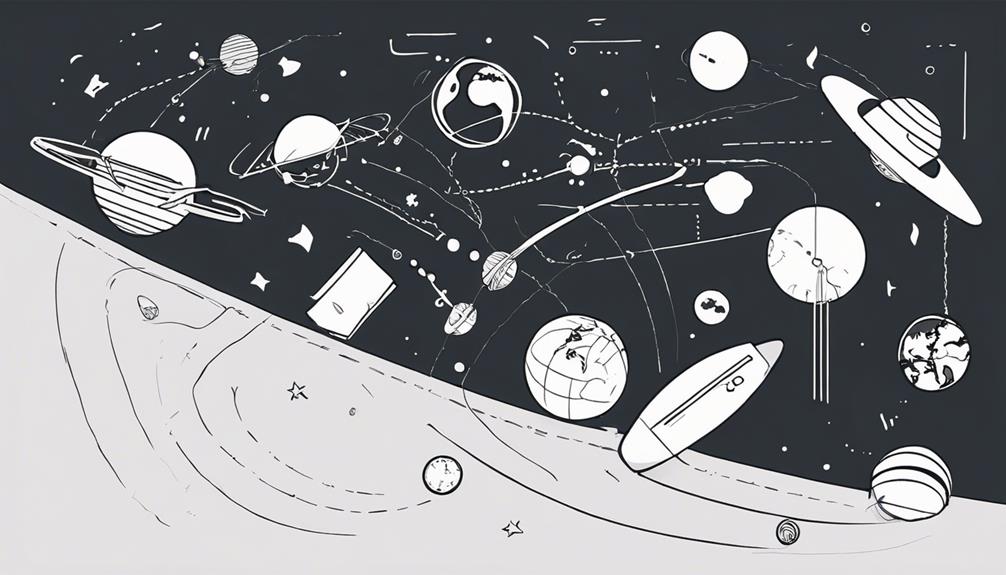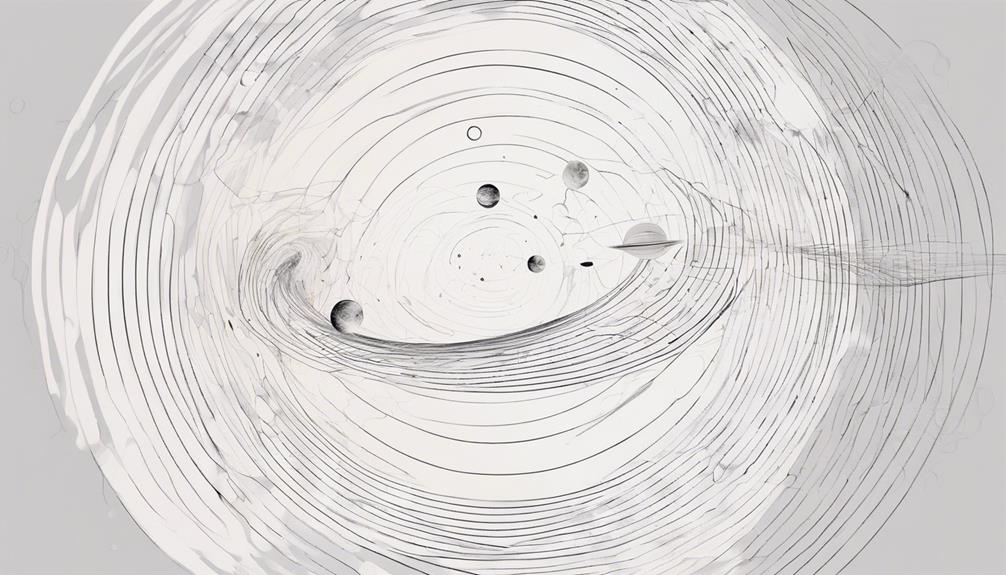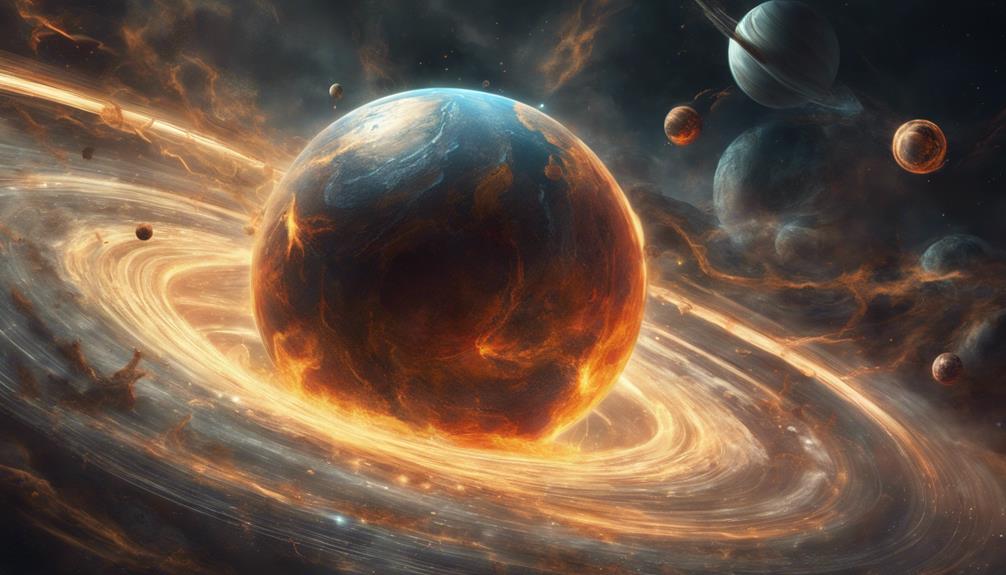The question of what causes gravity has intrigued scientists and thinkers for centuries, leading to profound insights into the nature of our universe. While gravity is a well-established force that governs the motion of celestial bodies and shapes the fabric of spacetime, the underlying cause remains a subject of ongoing exploration and debate. From Newton's elegant laws of gravitation to Einstein's revolutionary theory of general relativity, our understanding of gravity has evolved, yet mysteries persist. As we delve deeper into the complexities of this fundamental force, new perspectives and theories continue to emerge, challenging our perceptions of the cosmos and our place within it.
Key Takeaways
- Gravity arises from mass-energy interactions curving spacetime.
- Mass and energy distributions shape gravitational forces.
- Spacetime curvature by mass causes objects to attract.
- Gravity's origin lies in the interconnectedness of mass, energy, and spacetime.
Definitions of Gravity

Defining gravity as a fundamental force of attraction between objects in the Universe lays the groundwork for understanding its intricate workings within the fabric of spacetime. Albert Einstein revolutionized our comprehension of gravity with his theory of general relativity. According to this theory, massive objects like planets and stars cause a curvature in spacetime around them. This curvature is what we experience as the gravitational force. Einstein's concept superseded Newton's law of universal gravitation, providing a more comprehensive explanation for the behavior of mass in the Universe.
The theory of general relativity illustrates gravity not as a force acting at a distance, as Newton proposed, but as the result of spacetime being curved by mass. Objects moving through this curved spacetime follow paths that we perceive as gravitational attraction towards more massive bodies. This understanding fundamentally alters our perception of gravity, viewing it as a consequence of the geometry of spacetime rather than a mysterious force.
Historical Understanding of Gravity
During ancient times, scholars like Aristotle, Archimedes, and Brahmagupta laid the groundwork for early concepts surrounding gravity, setting the stage for future scientific advancements in understanding this fundamental force. The European scientists of the 16th century, including Galileo Galilei, played a pivotal role in revolutionizing the understanding of gravity. However, it was Isaac Newton's groundbreaking work in the 17th century, particularly his Laws of Physics and formulation of Newtonian gravity, that truly laid the foundation for modern gravity understanding.
Throughout history, there has been a remarkable historical evolution in gravity theories. Scholars like Al-Khazini, Giambattista Benedetti, and Simon Stevin made significant contributions that helped shape early gravity models. Their work, alongside that of other pioneers, paved the way for the development of more sophisticated theories regarding the nature of gravity. This historical understanding of gravity provides important context for appreciating the complexities of this fundamental force and the scientific journey that has led to our current comprehension of it.
Newton's Theory of Gravitation

Newton's Theory of Gravitation, a cornerstone in the realm of physics, postulates that every particle in the universe exerts an attractive force on every other particle, the magnitude of which is directly proportional to the product of their masses and inversely proportional to the square of the distance separating them. This concept is encapsulated in Newton's law of universal gravitation, where the gravitational force (F) between two masses (m1 and m2) separated by a distance (r) is given by the equation:
\[
F = rac{G \cdot (m1 \cdot m2)}{r^2}
\]
Here, G represents the gravitational constant. Newton's theory provided a fundamental understanding of how celestial bodies interact, explaining the motion of planets around the Sun and moons around planets. This classical mechanics framework accurately described many astronomical phenomena, laying the groundwork for modern physics. The gravitational force, as elucidated by Newton, remains a crucial aspect of our understanding of the universe's dynamics.
| Concept | Description |
|---|---|
| Gravitational Force | Attractive force between particles proportional to masses and inversely to distance |
| Masses | Amount of matter in the particles determining gravitational interaction |
| Distance | Separation between particles influencing the strength of gravitational attraction |
| Gravitational Constant | Value determining the strength of the gravitational force in the universe |
Modern Exploration of Gravity
Modern exploration of gravity delves into the intricate realm of gravitational waves detected by instruments like LIGO, providing tangible evidence for the existence of these ripples in spacetime. Physicists meticulously analyze the implications of these discoveries, aiming to reconcile the fundamental principles of general relativity with the tenets of quantum theory. The quest to unravel the mysteries of gravity in space and its potential quantum nature drives scientific inquiry towards a deeper understanding of the universe's fabric.
Gravity in Space
The exploration of gravity in space through modern scientific methods has provided compelling evidence supporting the fundamental theories of gravitational physics.
- Modern space exploration has confirmed the existence of gravitational waves, a key prediction of Einstein's General Theory of Relativity.
- Technologies like LIGO (Laser Interferometer Gravitational-Wave Observatory) have enabled the detection of gravitational waves from distant cosmic events.
- Studying gravity in space provides insights into the dynamics of massive celestial objects and their interactions.
- Observations of gravitational lensing in space reveal the bending of light due to massive gravitational fields, validating gravitational theories.
These observations, experiments, and missions, such as the Gravity Probe B, contribute to our understanding of gravity's role in the dynamics of the universe and the accuracy of Einstein's theories.
Gravitational Waves Discovery
How do gravitational waves revolutionize our understanding of the dynamics of the universe and the behavior of massive celestial objects? Gravitational waves, as predicted by Einstein's General Theory of Relativity, are disturbances in the fabric of spacetime caused by the acceleration of massive objects. The groundbreaking detection of these waves in 2015 by the Laser Interferometer Gravitational-Wave Observatory (LIGO) marked a new era in astrophysics. By observing gravitational waves from cataclysmic events such as black hole mergers and neutron star collisions, scientists can now study the universe in ways previously impossible. These waves travel at the speed of light, carrying crucial information about the most violent cosmic events, offering unparalleled insights into the nature of gravity and the behavior of massive objects in space.
Quantum Theory Implications
Exploring the implications of quantum theory on gravity delves into the fundamental forces at the smallest scales, aiming to reconcile the principles of general relativity with quantum mechanics.
- Quantum theory examines gravity at tiny scales, seeking to unify it with other fundamental forces.
- Hypothetical gravitons might serve as carriers of the gravitational force in quantum gravity theories.
- Quantum gravity models strive to explain gravity's behavior within the quantum mechanics framework.
- Research on quantum gravity addresses the challenge of understanding gravity in the context of quantum phenomena.
Einstein's Field Equations
Einstein's Field Equations form the mathematical backbone of general relativity, encapsulating the intricate relationship between matter, energy, and the fabric of spacetime. These equations elegantly depict how mass-energy equivalence warps the very geometry of the universe, dictating the gravitational forces that govern cosmic phenomena. By exploring the curvature of spacetime and the interplay of mass-energy, scientists can unravel the mysteries of gravity with a precision that continues to astound.
Curvature of Spacetime
The concept of spacetime curvature, as elucidated by Einstein's field equations, fundamentally redefines our understanding of gravity as a consequence of mass and energy interacting within the fabric of the universe. This curvature leads to gravitational effects such as attraction between objects and the distortion of their paths in spacetime. Einstein's theory elegantly connects the presence of mass and energy to the gravitational force experienced, showcasing the intricate relationship between matter and gravity. The gravitational pull observed, like that of the Sun on planets, stems from the curvature of spacetime caused by massive objects. This profound insight into the nature of gravity highlights the interconnectedness of mass, energy, and the structure of the universe.
Mass-Energy Equivalence
The concept of mass-energy equivalence, as elucidated by Einstein's field equations in the framework of General Relativity, establishes a fundamental link between mass, energy, and the gravitational properties of spacetime. Einstein's field equations describe gravity as the curvature of spacetime resulting from mass and energy, showcasing the intricate relationship between matter and the structure of the universe. This relationship is encapsulated in the famous equation E=mc^2, illustrating how mass can be converted into energy and vice versa, influencing the curvature of spacetime. By understanding mass-energy equivalence through Einstein's field equations, we gain insights into how mass and energy distributions in spacetime shape the gravitational properties that govern the universe's structure, providing a mathematical framework for comprehending the origin of gravity.
Gravitational Force Interaction
Gravitational force interaction, elucidated by the field equations of general relativity, intricately describes the curvature of spacetime resulting from mass and energy. The interaction between matter and spacetime, as described by Einstein's field equations, gives rise to the force of attraction known as gravity. Key points to consider include:
- Einstein's field equations describe gravity as the curvature of spacetime due to mass and energy.
- Gravity emerges from the interaction of matter, curving spacetime and creating a force of attraction.
- These equations illustrate how mass and energy shape the geometry of spacetime, resulting in gravitational effects.
- They offer a mathematical foundation for comprehending how massive celestial bodies interact gravitationally.
Gravity's Effects on Space and Time
How does gravity influence the fabric of spacetime and the motion of celestial bodies within it? According to Einstein's theory of relativity, gravity is not just a force but a curvature in the spacetime continuum caused by mass and energy. Objects with mass distort spacetime, creating what is known as gravity wells. These wells pull other objects towards them, illustrating the interconnectedness of mass, energy, and the curvature of spacetime.
In this model, spacetime is a unified concept, where space and time are intertwined, affected by the presence of mass and energy. Heavy objects such as the Sun or black holes create deep gravity wells, where the curvature is significant. Gravity always acts as a well, drawing objects towards massive bodies rather than pushing them away. The curvature of spacetime dictates the gravitational forces experienced by objects, emphasizing the relationship between mass, energy, and the structure of the universe.
Alternative Theories to Gravity

Within the realm of gravitational studies, various alternative theories have been proposed to augment or challenge the conventional understanding of gravity's mechanisms and effects. These theories offer intriguing perspectives on the nature of gravity:
- Brans-Dicke theory: Introduces a scalar field to modify gravitational interactions.
- String theory: Proposes gravity arises from closed strings vibrating in multiple dimensions, offering a quantum perspective on gravity.
- Modified Newtonian Dynamics (MOND): Suggests adjusting Newton's laws at low accelerations to explain galactic rotation curves without dark matter.
- Aristotelian theories: Relied on natural motion principles and elemental properties to explain objects' behaviors in the cosmos.
These concepts delve into diverse aspects of gravity, from quantum vibrations to the modification of classical laws, challenging traditional Newtonian frameworks. By exploring these alternative theories, scientists aim to unravel the mysteries of gravity and its effects on the universe, pushing the boundaries of our understanding of this fundamental force.
Frequently Asked Questions
What Is the Main Cause of Gravity?
Gravitational force is the universal attraction between objects with mass, described by the inverse square law. This force influences the curvature of spacetime, as theorized by Isaac Newton and later refined by Albert Einstein in his General Theory of Relativity. Massive objects create gravity wells, shaping the paths of surrounding objects. Gravitational waves are ripples in spacetime caused by accelerating masses. These concepts collectively explain the main cause of gravity in the universe.
How Is Gravity Created?
Gravity is explained by the concept of spacetime curvature resulting from mass and energy distribution. This curvature causes objects to move towards each other due to gravitational forces. Newton's theory of gravity initially described this force, but it was later refined by Einstein's general relativity, which explains gravity as a consequence of spacetime distortion. Quantum mechanics and gravitational waves further deepen our understanding of this fundamental force in the universe.
Why Does Mass Cause Gravity?
Mass attraction is a fundamental concept in understanding the gravitational force. Mass-density warps spacetime, causing a curvature that influences the gravitational pull between objects. This principle aligns with Newton's law of universal gravitation and Einstein's General Theory of Relativity. The relationship between mass and gravity is central to the theory of gravity, showcasing how the presence of mass inherently triggers the phenomenon of gravitational attraction.
What Two Things Cause Gravity?
Gravitational force is a fundamental interaction in the universe, arising from the curvature of spacetime caused by mass and energy, as described by General Relativity. This curvature results in mass attraction, leading to a gravitational pull between objects. Newton's law of universal gravitation quantifies this force, showing that it is inversely proportional to the square of the distance between objects. Therefore, the two main drivers of gravity are spacetime curvature and mass attraction.
Conclusion
In conclusion, the understanding of gravity as a fundamental force in the universe has evolved significantly over time, from Newton's theory of gravitation to Einstein's field equations. Gravity's effects on space and time have been crucial in shaping the structure and dynamics of the universe. As we continue to explore alternative theories to gravity, we are reminded of the profound impact that this force has on the behavior of celestial bodies and the fundamental laws of nature.
